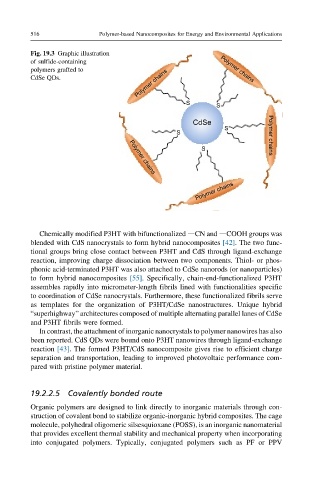Page 563 - Polymer-based Nanocomposites for Energy and Environmental Applications
P. 563
516 Polymer-based Nanocomposites for Energy and Environmental Applications
Fig. 19.3 Graphic illustration
of sulfide-containing
polymers grafted to Polymer chains
Polymer chains
CdSe QDs.
S S
CdSe
S
S Polymer chains
S
Polymer chains
Polymer chains
Chemically modified P3HT with bifunctionalized dCN and dCOOH groups was
blended with CdS nanocrystals to form hybrid nanocomposites [42]. The two func-
tional groups bring close contact between P3HT and CdS through ligand-exchange
reaction, improving charge dissociation between two components. Thiol- or phos-
phonic acid-terminated P3HT was also attached to CdSe nanorods (or nanoparticles)
to form hybrid nanocomposites [55]. Specifically, chain-end-functionalized P3HT
assembles rapidly into micrometer-length fibrils lined with functionalities specific
to coordination of CdSe nanocrystals. Furthermore, these functionalized fibrils serve
as templates for the organization of P3HT/CdSe nanostructures. Unique hybrid
“superhighway” architectures composed of multiple alternating parallel lanes of CdSe
and P3HT fibrils were formed.
In contrast, the attachment of inorganic nanocrystals to polymer nanowires has also
been reported. CdS QDs were bound onto P3HT nanowires through ligand-exchange
reaction [43]. The formed P3HT/CdS nanocomposite gives rise to efficient charge
separation and transportation, leading to improved photovoltaic performance com-
pared with pristine polymer material.
19.2.2.5 Covalently bonded route
Organic polymers are designed to link directly to inorganic materials through con-
struction of covalent bond to stabilize organic-inorganic hybrid composites. The cage
molecule, polyhedral oligomeric silsesquioxane (POSS), is an inorganic nanomaterial
that provides excellent thermal stability and mechanical property when incorporating
into conjugated polymers. Typically, conjugated polymers such as PF or PPV

